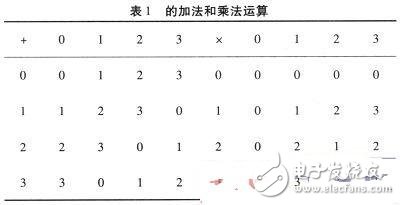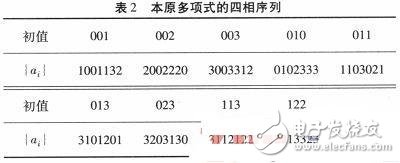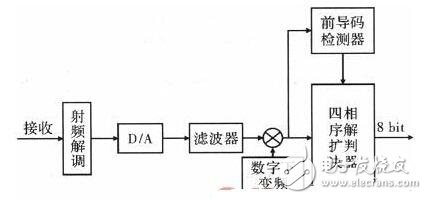The four-phase sequence spread spectrum modulation and demodulation method is introduced, and the four-phase sequence spread spectrum and QPSK are simulated under Gaussian white noise channel conditions. The simulation results show that compared with the traditional multi-ary orthogonal spread spectrum system, the scheme greatly improves the data transmission rate and anti-interference ability, and can be well applied to high-speed data communication. The direct sequence spread spectrum method directly modulates the carrier by pseudo-noise locating, adapts to the harsh channel environment, and has strong anti-interference ability, and thus has received extensive attention and application, such as ranging, anti-human and natural interference, Anti-fading, low power spectral density, anti-listening, code division multiple access, etc. Compared with the traditional direct-spreading system, the multi-ary orthogonal spread spectrum system has higher spreading gain under the same information rate and system bandwidth, which can effectively solve the contradiction between transmission bandwidth and processing gain. A composite modulation scheme (NOrth-MDPSK) combining N-ary orthogonal spread spectrum and M-ary differential phase modulation is proposed in the literature, and its performance is analyzed. The composite modulation scheme (DNOrth-MDPSK) combining double-multiple orthogonal spread spectrum and M-ary differential phase modulation is also mentioned in the literature, and its data rate is further improved, but due to the use of non-coherent envelope and difference The detection and the need to distinguish between single and double codes, so performance has decreased. In this regard, this paper proposes a composite modulation scheme combining four-phase sequence spread spectrum and BPSK, and simulates it under the condition of Gaussian white noise channel. The result proves the superiority of this scheme. Due to the limitation of channel bandwidth and anti-interference ability, four-phase sequence spread spectrum technology is adopted, and four-phase sequence spread spectrum can achieve higher spread spectrum processing gain while maintaining a lower signal bandwidth. The four-phase sequence spread spectrum technique selects several sets of quasi-orthogonal spreading codes, and each 31 spreading codes carry 8 bits of information for transmission. Each group of spreading codes transmits 8 bits. If the transmission rate is 4 Mbit.s-1, the channel symbol rate after spreading is 4Mbit.s-1&TImes; 31 bit/8 bit=15.5 Mbit.s-1, press The 2x symbol rate is calculated to have a transmission bandwidth of 31 MHz. In actual use, the four-phase spread spectrum sequence is filtered by baseband shaping, and the transmission bandwidth can be reduced to less than 28 MHz. The definition of four-phase sequence: The group A four-phase sequence on Z4={0,1,2,3} is defined by a recursive equation of non-all zeros, and its characteristic polynomial is an irreducible source element on A4, where r is a feature The order of a polynomial whose polynomial can be expressed as The addition and multiplication operations in the equation are performed on Z4, and the calculations on Z4 are shown in Table 1. Since only integers 1 and 3 have inverse elements under integer-based multiplication, the selection of the coefficient p0 is limited, and the key to obtaining the cyclic sequence is the initial state of the shift register. Taking the third order as an example, nine different initial values ​​are assigned to the characteristic polynomial f(x)=x3+2x2+x+3, and nine four-phase cyclic sequences of length 7 are obtained, as shown in Table 2. Each initial sequence undergoes a 5-level shift and a feedback modulo 4 calculation to obtain 31 quasi-orthogonal sequences, which together produce 279 sequences, satisfying the 256 spreading sequence requirements of 8 bits. In order to accurately estimate the spreading sequence synchronization header, this paper performs preamble insertion on the transmitted data. The data frame structure is as shown in FIG. 1. Each frame of data includes a 32-bit preamble and 31 spreading code groups, and each spreading code group is a four-phase sequence of 31 symbols. Phase correction is performed by inserting a preamble so that the sequence can be accurately synchronized. Figure 1 Schematic diagram of modulation data frame structure The four-phase sequence spread spectrum modulation structure is shown in Figure 2. In addition to the preamble sequence, the other 31 sets of 8 bit data are used to select the corresponding four-phase sequence spreading code, which is mixed with the preamble, then digitally upconverted, DA outputted analog signal, and finally RF modulated. The data rate is 4: Mbit.s-1, and 32 bit synchronization codes are inserted for every 31 spreading code groups. The number of data bits modulated by each spreading frame interval is 280, and the number of effective data bits is 248, which greatly improves the number of bits. The transfer rate of data. As can be seen from Figure 2, the IF signal is 112 MHz and is upconverted to a 2 400 MHz output. Figure 2 Flow chart of four-phase sequence spread spectrum modulation transmission The demodulation unit structure of the four-phase sequence spread spectrum system is shown in Fig. 3. The received signal is first subjected to radio frequency demodulation to obtain a multi-frequency domain frequency signal, which is sent to the preamble detector after D/A quantization, digital filtering and digital down-conversion, and is also sent to the four-phase sequence despreading correlator, preamble The detector finds the spread spectrum synchronization signal, and after receiving the synchronization signal, the phase sequence despreading correlator performs correlation calculation on the received data and the spreading sequence to find a corresponding 8-bit data output, wherein the detailed description of the four-phase sequence despreading module The structure is shown in Figure 3. Figure 3 Receive channel information processing flow chart Fig. 4 Performance simulation of four-phase spread spectrum and QPSK under Gaussian information The transmission rate of 4 Mbit.s-1 is simulated by Gaussian channel using four-phase sequence spread spectrum and QPSK. The four-phase sequence spread spectrum is a four-phase sequence spread spectrum (31 QPSK symbols) mapped into 31 symbols per 8 bit information data (4 QPSK symbols), and the theoretical gain of the four-phase sequence spread spectrum is 10 log (31/). 4) = 8.9 dB. From Figure 4, it can be analyzed that the four-phase sequence spread spectrum has the same performance at SNR=2 dB and QPSK at SNR=11 dB, and the error level is 7e-4. Four-phase sequence spread spectrum is in SNR. At 2 dB, the performance improvement is obvious. Each time, 8 & TImes; 105 data are simulated, and no error occurs; in the same case, QPSK still has errors when the SNR reaches 13 dB. It is verified by simulation that the four-phase spread spectrum data is grouped by 8 bits in the case of limited bandwidth. The performance of channel coding of four-phase spread spectrum is more obvious than QPSK, which can improve signal gain and reduce The bit error rate provides good technical support for spread spectrum high-speed communication. Fork Type Connecting Terminals Fork Type Connecting Terminals,Terminals,Connecting Terminals Taixing Longyi Terminals Co.,Ltd. , https://www.longyicopperterminals.com





